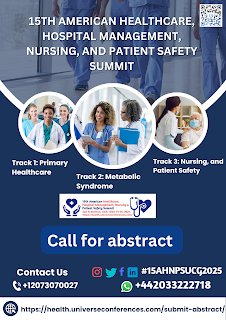Track 20: Occupational and Safety Health:-
Track 20: Occupational and Safety Health:-
Introduction:-
A multidisciplinary field
concerned with the safety, health, and welfare of individuals at work is known
as occupational safety and health (OSH), also known as occupational health and
safety (OHS), occupational health, or occupational safety (i.e. in an occupation).
These terms initially served as an acronym for occupational safety and health
program/department/etc. since they also allude to the field's objectives.
Fostering a safe and healthy work
environment is the aim of an occupational safety and health programme. All
members of the general public who might be impacted by the workplace environment are
likewise protected by OSH.
An accident or illness related to
the workplace claims the lives of more than 2.78 million people worldwide each
year, or one every fifteen seconds. Every year, there are an extra 374 million
nonfatal workplace accidents. According to estimates, the annual economic cost
of occupational illness, injury, and death is close to 4% of the world GDP.
This adversity has a high human cost.
Employers are required by common law (also known as the duty of care) to take reasonable precautions for their employees' safety in common-law jurisdictions. The specifics of this differ from jurisdiction to jurisdiction, but statute legislation may also impose more general obligations, add new particular obligations, and establish government entities with the authority to regulate occupational safety issues.
Contents:-
1. Introduction
2.
Definition
3.
History
5. Conclusion
Definition:-
"Occupational
health deals with all elements of
health and safety in the workplace and has a strong focus on primary prevention
of hazards," according to the World Health Organization (WHO). "A
state of complete physical, mental, and social well-being and not only the
absence of disease or disability" is the definition of health. The goal of
the multidisciplinary medical area known as occupational health is to help
people work in ways that are least harmful to their health. It is in line with
the advocacy for workplace health and safety, which is focused on preventing
injury from dangers. [Reference needed]
The
International Labour Organization (ILO) and the World Health Organization (WHO)
have agreed on a definition of occupational health since 1950. The Joint
ILO/WHO Committee on Occupational Health adopted it at its first session in
1950, and at its twelfth session in 1995, it underwent revisions.
History:-
16-year-old
Harry McShane in 1908. His arm was severed at the shoulder and his leg was
fractured without any financial compensation after he was pulled into factory
equipment in Cincinnati.
Occupational
safety and health research and regulation are relatively new developments.
Workers' health started to be taken into account as a labor-related issue as
labour movements emerged in the wake of the industrial revolution in response
to worker concerns.
The
health risks of chemicals, dust, metals, repeated or violent motions, strange
postures, and other disease-causing factors experienced by employees in more
than fifty jobs were described in 1700's De Morbis Artificum Diatriba. Concerns
about the bad health of children working in cotton mills led to the early
nineteenth century Factory Acts in
the United Kingdom (from 1802 onward). The Act of 1833 established a
specialised, professional Factory Inspectorate. The Inspectorate's initial
mandate was to oversee limitations on the number of hours that children and
young adults might work in the textile sector (introduced to prevent chronic
overwork). However, a second Act restricting the number of hours that women
could work in the textile sector in 1844 imposed a requirement for machinery
guarding at the Factory Inspectorate's insistence (but only in the textile
industry, and only in areas that might be accessed by women or children).
Workplace risks:-
Many
health and
safety warning ads, including this one about ladder safety, have attempted
to reduce workplace dangers.
A
wide range of workplace hazards (sometimes referred to as unsafe working
conditions) poses threats to people's health and safety at work even while
labour has numerous financial and other rewards. These include a wide range of
psychological risk factors in addition to "chemicals, biological agents,
physical factors, bad ergonomic conditions, allergies, and a complex network of
safety dangers." Long working hours are the occupational risk factor with
the highest attributable burden of disease, according to a landmark study by
the World Health Organization and the International Labour Organization, which
estimates that 745,000 people died from ischemic heart disease and stroke
events in 2016. As a result, overwork is now the main risk factor for
occupational health worldwide.
Many
workers are affected by physical risks at
work. With 22 million workers exposed to dangerous noise levels at work and
an estimated $242 million spent each year on worker's compensation for hearing
loss impairment, occupational hearing loss is the most prevalent work-related
ailment in the United States. Falls are another typical source of occupational
injuries and fatalities, particularly in the cleaning and maintenance of
buildings, extraction, transportation, and healthcare industries. Machines can
crush, burn, cut, shear, stab, or otherwise strike or injure employees if
operated improperly because they have moving parts, sharp edges, hot surfaces,
and other risks.
Do contact us:-
Visit: https://health.universeconferences.com/
WhatsApp us at: +44 2033222718
Email at: health@ucgconferences.com
Call: +44 2033222718 / +12073070027
Submit your research work here: https://health.universeconferences.com/call-for-paper/
Previous Blog post
Links:-

.png)


Comments
Post a Comment